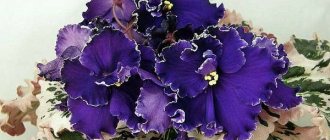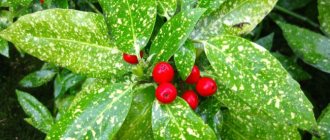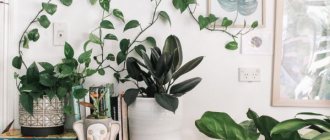Indoor plants are what add comfort and harmony to any home. Fresh flowers make a home more complete and enjoyable.
Monster
But if you want them to bloom and grow for a long time, you need to know their characteristics when planting and caring for them, because each plant with large leaves is different from each other.
Abutilone
There is a beautiful plant from the mallow family, also known as the indoor maple. And for good reason—these large-leaved, peaceful plants are something of an heirloom tree. Abutilon blooms with bright, large flowers that are pleasing to the eye and add elegance to any home. The flowering period is quite long - from May to October, so you can enjoy all this splendor. The plant loves warmth, about 20-30 degrees, but not lower than 15 degrees in winter. Water thoroughly and keep in a sunny location.
Aglaonema photo
The Aglaonema plant is a member of the aroid family. This genus includes about 20–50 species. The plant is naturally found in the rain forests of tropical New Guinea, the Malay Archipelago, as well as in Southeast Asia along river banks in the lower forest belts and plains.
Aglaonema is an evergreen herbaceous plant. The short and straight stem is quite fleshy. There are species in which the trunk begins to branch at the base. The stem is present only in mature plants, and its formation occurs due to the flight of the lower leaf plates. The color of the foliage directly depends on the type and variety of the plant. The shape of the dense, leathery leaf plates to the touch is ovoid or lanceolate. They are attached to the trunk by petioles, which can be long or short. The edge of the leaves is solid, while the plate is patterned, and on its front surface there is a depressed midrib, while on the reverse side it is convex. At the top of the plant, from the axils of the leaves grow from 1 to 3 ears with a greenish-white cover; they are the inflorescences of aglaonema. Depending on the type of plant, the cobs are divided into 2 types:
- thick club-shaped - reach 10 mm in diameter and their length is 40 mm;
- thin cylindrical - their length is about 60 mm, and their diameter reaches 5 mm.
Avocado
Everyone has heard the name of this beautiful plant that came to Europe from America. Currently, avocado has become a common plant in Russia. Thanks to its large stature, it can grow up to 20 meters in height. It can be used as a houseplant or to decorate porches and outdoor patios. Indoors it can reach a height of up to 1 meter. Its elongated, long, thick leaves grow in a bush-like shape, making it an ideal addition to any corner of the home. Avocados love high humidity, so they should be watered frequently.
Indoor plants with large leaves
Not everyone likes flowering plants. Many people are looking for an indoor tall flower with large leaves that will delight with its greenery. And these are also on sale.
Monstera
Ficus - varieties with small and large leaves, variegated and dwarf
The plant is interesting because it has large leaves, up to 30 cm in length. Monstera is also called “crybaby” due to the fact that drops of water appear on the surface of the leaf blades. This happens only before rain, so another name for monstera is fortune teller flower.
Monstera Adanson reaches a height of 8 m, its thin leaves are pierced with many holes. At home it rarely blooms, but if this happens, the peduncle does not grow more than 30 cm, and the flower itself is white-yellow.
Monstera Borghisa is distinguished by carved leaves that are unevenly colored in shades of white and green. Variegated varieties are distinguished by the fact that the plant combines different shades. Such specimens will be an excellent decoration for your apartment.
Fatsia
There are different indoor flowers with large leaves. Fatsia resembles a small house maple. The plant perfectly purifies the air and grows quickly.
Important! Only one species is bred at home - Fatsia japonica.
The plant is widely used for decorating shop windows, walls, and pillars. It grows 1 m per year. The peculiarity of Fatsia is that it needs good lighting and moist air. Therefore, it is sprayed 2-3 times a day and watered 4-5 times a week.
Croton
Among tall indoor plants, codiaum, also called croton, stands out especially. It is capable of reaching a height of 8 m. The plant is capricious, this is especially noticeable after four years of growth.
Before noon, the plant needs bright light, then light shading. Watering is required regularly and moderately, about 3-4 times a week.
Variegated varieties grow well only with high air humidity. Therefore, crotons are sprayed twice a day. Twice a month the plant is washed under a warm shower.
Croton grows up to 10 years, but any changes in the maintenance regime will lead to death. Therefore, this plant is not suitable for beginner gardeners. Despite the fact that this is not a flowering species, this does not make it any less beautiful.
Anthurium
One of the exotic and beautiful tropical plants, which is also called flamingo flower. It owes its name to its unusual and beautiful appearance. Many people often wonder how to find out the name of a houseplant with unusually shaped flowers. Anthurium is one of the most magnificent plants in the flower world. Its leaves are quite large and heart-shaped, and its flowers are unusual. They are bright and shiny and resemble little hearts. Anthuriums come in different types and colors, so you can choose a flower for any interior.
Indoor outdoor flowers
Unusual indoor plants and tropical flowers
Many people are accustomed to the fact that different types of flowers are placed only on windowsills. But many species can be placed on the floor, and they will grow well there. Such interesting and large house plants will decorate any home.
Chrysalidocarpus Areca
It belongs to palm trees and loves light, so this species cannot be called shade-loving. In summer, it needs high air humidity. Therefore, the flower needs to be washed regularly and containers of water should be placed next to it.
The plant reaches a height of 3 m
Note! The beautiful chrysalidocarpus Areca blooms very rarely at home, but this does not reduce its decorative properties.
Dracaena
The flower resembles a palm tree. Its spectacular and attractive appearance has made dracaena popular not only for home maintenance, but also for offices and public places.
Important! Dracaena is represented by different varieties, which can be either monochromatic or variegated.
Only monochromatic species require little light. The rest need good lighting. Dracaena does not tolerate dry air, and is regularly sprayed and bathed in a warm shower once a month.
This plant is called moisture-loving, since in summer it needs to be watered every day, and in winter once every 2-3 days. Cats love to eat dracaena, so you need to limit pets' access to the flower.
Hovea
It is unpretentious. All you need is good lighting and warmth. In a spacious room it grows up to 5 m, but this is rare. Average height is about 3 m.
Important! Khovea is a moisture-loving crop, so the top layer of soil should always be moist.
The single-trunk palm is characterized by slow growth. Over the course of a year, it may develop 3-4 leaves. With proper care, she can live 30-40 years.
Room bells
The flowers do not differ in height, but they bloom profusely. They are also called campanula. Thin shoots are highly branched, bells can reach a length of 4 cm.
A palette of colors from delicate white shades to rich blue and purple colors
Often the flower is grown as an annual, but even in a short period of time it manages to please the owner.
Monstera deliciosa
A large vine that can grow up to 9 m. It does not like rearrangements, so it is better to immediately choose the right place for growing.
Monstera thrives in the shade and needs plenty of watering. In summer, the plant must be sprayed two to three times a day. The vine does not have a trunk, so it needs special support.
There are different large indoor flowers. With their help you can make any room original and unusual. The main thing is to choose the right type.
Supply valve NORVIND OPTIMA
1800 ₽ More details
Supply valve NORVIND PRO
2470 ₽ More details
VPR 2nd grade in mathematics
Alocasia
This large plant is also called elephant ear. It is not named so in vain, because it has no equal in the beauty and size of its leaves. Its dark-colored leaves are very large and flat. Alocasia grows quickly and can reach a height of 1.5 meters. Its beautiful shape and size make it an ideal ornamental plant for large areas. However, keep in mind that it is quite difficult to care for. Alocasia loves warmth and grows well at temperatures not lower than 18 degrees. It also requires constant soil moisture and fertilization.
Flowers for the floor: 10 best indoor trees
Plants not only purify and humidify the indoor air, but also decorate the interior. Indoor trees cope especially well with these tasks. Among them there are both capricious and completely unpretentious, and the main thing in caring for both is timely transplantation. About 10 indoor trees that fit best into the interior.
Monstera. A large tropical plant, beautiful and quite unpretentious. As it matures, holes appear on its leaves, which later turn into cuts. The plant is very thermophilic; in winter the room temperature should not be allowed to drop below 17 degrees. Grows best in a sunny location, away from direct sunlight. Monsteras tend to grow quickly and grow very strongly. The height of the plant can reach 5 m. It is moisture-loving, requires abundant watering, but the soil should dry out between waterings.
Chinese rose (hibiscus). From a small shoot a whole tree can grow, which will delight you with its bright flowers of various shades. Because of its unpretentiousness, hibiscus often becomes a resident of various government institutions, for example, clinics and libraries. In summer, hibiscus should be watered at least twice a week. If the leaves begin to fade, the amount of watering needs to be increased. A Chinese rose will be lush if you periodically pinch the tops of the side branches. It is best to keep the flower in a bright place, but not in direct sunlight.
Ficus benjamina . The plant is native to countries with a hot, humid climate: the Philippines, China, Australia, India. In open ground, the plant can reach 20 m in height, but at home, ficus grows up to three meters. Ficus Benjamina is a true touch-me-not. First of all, he needs a permanent place in the house. If a flower is rearranged, rotated and moved, it may become “offended” and drop all its leaves. The choice of location must be approached responsibly: Ficus Benjamin does not like cold, darkness, or drafts. The plant needs to be sprayed periodically, and a full shower should be given about once a month. The main task when caring for ficus is to prevent the soil from becoming waterlogged or dry out.
Laurel. At home, laurel grows up to 1.5-2 meters, lends itself well to decorative processing - when pruned, it takes on any desired shape. Laurel laurel is most often grown in homes and offices. Laurel needs bright lighting; its dense leaves are not in danger of being burned. Direct sunlight is preferable to a shady location. In rooms with high air humidity, laurel turns green and grows well. The laurel will be very happy with frequent spraying and soul. In the warm season, the plant requires abundant watering; the soil should not dry out.
Dieffenbachia. Dieffenbachia grows quickly, absorbs harmful substances from the air and pleases the eye with beautifully colored leaves. True, you need to be careful when handling it - Dieffenbachia juice is poisonous. This flower grows at home up to 2 meters. To maintain the variegated color of the leaves, the flower needs a good level of light, even in autumn and winter. In summer, the plant needs to be shaded so that direct sunlight does not burn the tender leaves. These indoor flowers do not like drafts and may even shed their lower leaves as a “sign of protest”. In spring and summer, Dieffenbachia requires abundant watering (2-3 times a week), in winter - no more than once every 7-8 days. You can spray the flower with settled water at least every day.
Indoor maple (abutilone). Indoor maple reaches a height of 1.5 m; at home it grows and blooms well from spring to autumn. If the room temperature does not exceed 15 degrees, then it can bloom all winter. Indoor maple prefers bright sunny places. In summer, it is better to move it to the balcony. In spring and summer, abundant watering is required; in winter, moderate watering is required. At temperatures above 20 degrees, the plant needs to be moistened more often by spraying.
Hovea. According to experienced gardeners, howea is the best home palm tree. In the natural environment it grows up to 15 m in height, at home it reaches 1.5-2 m. In fertile soil it will grow quite quickly. It is undemanding in terms of lighting and air humidity, quite resistant to drought, and if the soil is periodically dried out, this does not affect its appearance in any way. But, of course, howya will feel best with plenty of light, water, humidity and plenty of air.
Rapis. Rapis is another palm tree that is incredibly easy to care for. Until relatively recently, indoor floriculture mainly cultivated low rapis (it grows up to 1.5 m), but today high rapis is also gaining momentum (it easily grows up to 3 m). The plant is quite light-loving and can even survive a small amount of direct sunlight, but it also feels great in partial shade. In order for the crown to be beautiful and uniform, you need to periodically turn the rapis. Rapis is absolutely undemanding to air humidity, but spraying, especially in summer, will not harm it. In summer, watering is plentiful, in winter - moderate, but the soil should always be moist.
A coffee tree. In indoor conditions, the coffee tree usually grows up to 1.5 m high, but with proper care and a spacious room, its height can reach 3 m. The coffee tree is very afraid of drafts, but prefers well-ventilated rooms. Does not tolerate proximity to any indoor plants. Loves bright diffused light and frequent spraying with warm water. Water the coffee tree sparingly, but without waiting until the top layer of soil dries out.
Dracaena. The tree-like dracaena can reach a height of 3 m, crowned with a bunch of leaves resembling a disheveled hairstyle. The leaves are long and narrow. As the plant grows, the leaves fall off, forming a characteristic pattern of scars on the trunk. Most types of dracaenas should be placed in a bright place, protected from direct sunlight. It is best to choose an east or west window for them. Species with dark leaves require less light than variegated ones. In the absence of sufficient light, variegated species may lose color. Artificial lighting is suitable for dracaenas. This is a moisture-loving plant and needs abundant watering. Over-drying of the earthen coma is unacceptable; moreover, the earth should remain slightly moist all the time. Be sure to spray the plant and wipe the leaves from dust.
Aspidistra
This plant is well known in the East and is widely cultivated in China and Japan. Due to its hardiness and undemanding nature, it is called the iron flower. It has almost no stems, and the leaves grow from the ground. Thanks to their thick, elongated shape, they look great in any room and create a cozy atmosphere. Aspidistra is easy to grow and very easy to care for. Plants should be kept out of direct sunlight as they are shade-tolerant. Ideal for decorating stairs and indoor corridors. Aspidistra is available in various varieties, both with plain leaves and as a houseplant with white-green leaves. A pattern of bright stripes runs along the entire length of the sheet in thin stripes.
Dieffenbachia
Originally from Brazil, this plant has become popular in Europe due to its beautiful appearance and unpretentiousness. Dieffenbachia is easily recognizable among many other plants due to its exotic appearance. Its large, smooth leaves have unusual whitish-cream spots along their entire length. It is often used to decorate various rooms.
Dieffenbachia
Dieffenbachia is easy to care for. It can grow unhindered in a warm room without direct sunlight. With a lack of light, the leaves lose their color and the white spots become dull. Water sparingly and mist frequently.
Dieffenbachia photo
Many housewives love to decorate their apartments with flowers. Some people like tall palm trees and plants with large, fleshy leaves. Others enjoy the unusual blooms. But everyone strives to purchase a plant that will complement the interior, making it cozy. For example, many people like Dieffenbachia. At home, the plant rarely reaches a height of 2 meters. At the same time, in nature (in tropical forests) there are often specimens where only the leaves grow up to 50 cm. Depending on the external color and size, different types of plants are distinguished. The most common are Dieffenbachia spotted and variegated. It is from them that numerous varieties of this beautiful home flower originate.
Each of us must have furniture in our apartment. Did you know that formaldehyde and other harmful substances that release toxins into the air are used in the manufacture of tables, chairs, cabinets and beds? Dieffenbachia absorbs them well, releasing oxygen. The plant also purifies the air from xylene and toluene and absorbs harmful fumes that are released when working with household chemicals. It is not surprising that this home flower is recommended to be grown by all those who live near large industrial enterprises, highways, and in megacities.
It is believed that the plant shows special gratitude to the housewives who care for it. Dieffenbachia gives precious energy, which improves a woman’s well-being and appearance. The plant is best installed in an office or study, in rooms where negotiations take place. But placing flowers in the bedroom and children's room is not recommended. Those gardeners who claim that the plant is poisonous are also not mistaken. But in reality, everything is not so scary, since harmful substances that burn the skin are found in Dieffenbachia juice, which is released when the stem is broken or the leaf is torn. It contains alkaloids that may cause swelling or irritation. Moreover, the reaction does not always appear immediately after contact with the skin. Since the plant propagates by stem and apical cuttings, it has to be broken when replanting. It is enough to put on rubber gloves and wash your hands with regular soap after work. This will save you from possible problems.
Maranta
This unusual and colorful plant grows in Central America. Arrowroot is one of the most wonderful plants that can be found in any home today. It is quite low-growing and short-stemmed, with beautiful, bright, oblong leaves. Bright burgundy and cream leaves run throughout the foliage, giving the flower a distinctive pattern. Maranta loves warmth and sunlight. Store at a temperature not lower than 18 degrees. Constant watering and spraying will ensure longevity for this plant.
And for a long time it will decorate any room with its unusual beauty.
Monstera
Monstera is another unusual and exotic plant brought to Europe from Central America. Monstera is easily recognizable among many other flowers due to its unusual appearance. Its large leaves are deeply cut and oblong in shape. Thanks to its beauty, Monstera has gained popularity among flower growers around the world. Since it is a tropical plant, it loves high humidity and warmth. Another distinctive feature of this flower is its aerial roots that grow above the soil. They should never be trimmed.
Monstera photo
Monstera is a beautiful evergreen plant that belongs to the liana family. This is one of the most common indoor plants. Young leaves are whole, with age they become perforated, and then completely split. Monsteras are widespread in Central and South America. The gigantic size of the plant and its bizarre appearance served as the basis for the name of the entire genus (from monstrum - monster, and perhaps “bizarre”).
Latest articles for gardeners, gardeners and flower growers
Pruning cherries in the fall for beginners in pictures step by step
What to plant after tomatoes next year
What to plant after strawberries in the fall
Planting garlic in autumn before winter in Siberia
Monsteras are evergreen plants, vines, and shrubs with thick climbing stems and often hanging aerial roots. The leaves are large and leathery. The petiole is long, vaginal at the base. The inflorescence is a spadix, thick, cylindrical. The flowers at the base of the spadix are sterile, higher up they are bisexual. In general, monsteras are unpretentious and quite easy to grow, and perhaps that is why these evergreen tropical vines with beautifully dissected dark green leathery leaves with slots and holes of various shapes are one of the most common indoor plants. You just need to take into account that even in indoor conditions these plants stretch several meters, so it is better to grow them in cool and spacious offices, foyers and hallways. Can be used for shading (as climbing plants) and for trellises.
Monsteras take root ideally in heated winter gardens. The plant promotes ionization of indoor air.
Syngonium
The homeland of this plant is South America, but it has also taken root in Europe. Due to its unusual appearance and large size, syngonium has become quite popular. The plant has a long stem ending in beautifully shaped leaves. Syngonium belongs to the vine family and will grow tall and curl at the top of the plant if it finds support. The plant is quite undemanding and grows at temperatures not lower than 18 degrees. Wipe and spray the leaves daily, water, albeit moderately, but constantly. Excessive watering can cause leaves to rot. With proper care, the syngonium will decorate any home for a long time.
Large large indoor plants
With the help of large flowers you can hide imperfections in the interior or emphasize some parts of it. They look good with high ceilings and spacious rooms. They are often unpretentious, and even a beginner can take care of such specimens.
A wide variety of species allows you to choose a plant for any room
With proper care, large indoor flowers can grow up to 2-3 m in height. This must be taken into account when choosing specific types. They may differ not only in size, but also in leaf color.
Palm trees
The family is represented by different plant species. Washingtonia can grow up to 30 m in nature; in a room its growth is limited by the ceiling. It is better to keep it in a winter garden or a spacious cottage.
Important! Large leaf plates are decorated with thread-like curls.
Livistona is distinguished by wide fan-shaped leaves. The coconut tree is notable for the fact that it does not have a trunk until it reaches four years of age. At home it grows up to 2.5 m. Large feathery leaves are collected in a rosette on the crown.
In 10 years, a coconut tree can bear nuts
The Licuala tree is distinguished by large pleated leaves in the shape of a fan.
Ficus
The family is distinguished by great species diversity. There are both large house plants and small-leaved specimens. The rubber, white and elastic species are distinguished by their large height, up to 2-3 m. The leaves can reach a length of 15-20 cm.
Small-leaved plants, such as Ficus Benjamin, are classified as spotted species. The white border adorns the green leaves and gives the plant a decorative appearance. The flower grows up to 2 m in height and does not require special care.
Hibiscus
Refers to indoor floor flowers. Unpretentious, therefore popular for keeping in offices and public places.
Hibiscus is also called Chinese rose
There are many varieties that differ in flower shades. They reach a diameter of 15 cm. The leaves are shiny and green with jagged edges. Indoors, hibiscus grows up to 2.5 m.
Scheffler
Native to Australia, this plant is popular for its tall growth and beautifully shaped leaves. Its decorative appearance will decorate any room and make it cozy and beautiful. Schefflera is also known as the umbrella tree. It gets its name from its long, thick stem that makes it look like a small tree, with small leaves that open out like umbrellas at the ends. The unusual shape of the leaves is one of the most characteristic features of this plant. Schefflera requires regular watering and tolerates shade.











